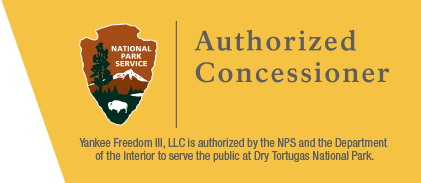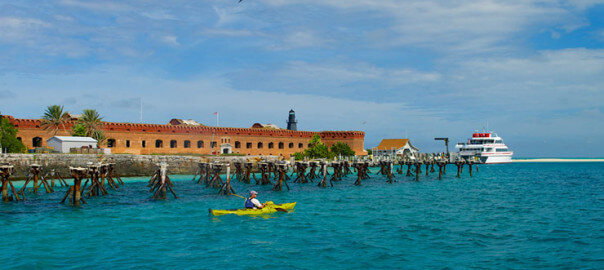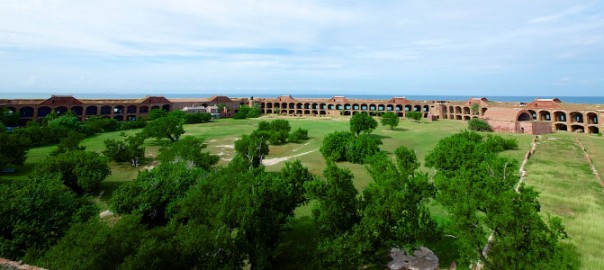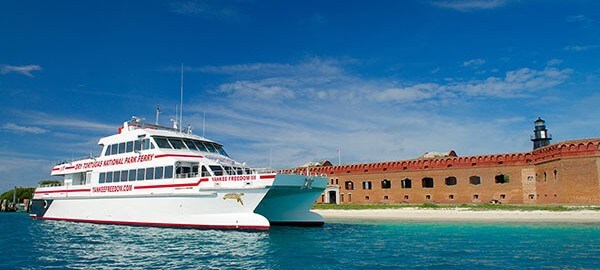Dry Tortugas – Our Favorite Places
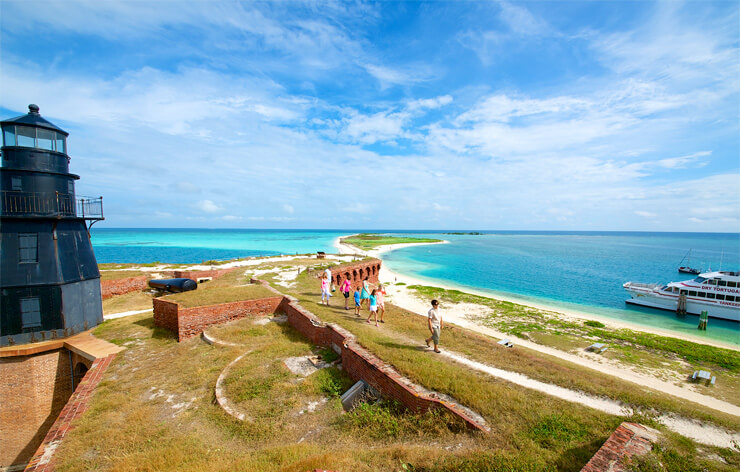
Scott Croft
NATIONAL PARK
In the middle of the ocean at the end of the Florida Keys sits a structure so bold that it’s been called the “Gibraltar of the Gulf.” Precariously perched on a spit of sand, Fort Jefferson, a pre-Civil War outpost, was once a key part of our coastal defenses. But today this mighty edifice, 68 miles from Key West, is a national treasure under ownership of the National Park Service.
Located in the Dry Tortugas National Park, Fort Jefferson is now recognized as an historic and natural gem that is drawing boaters from around the world. While the entire park encompasses about 100 square miles, the area is most well known for this brick-clad bastion which sits on 21-acre Garden Key, one of seven small Dry Tortugas islets.
Bathed by the clearest and cleanest waters of the Keys, the Tortugas are also part of the Florida Keys National Marine Sanctuary. The Tortugas sit at a crossroad of bio-diversity with the Florida current delivering a steady flow of marine life. Rich fish stocks make it the only avian rookery in North America for sooty terns, masked boobies and frigate birds.
Fort Jefferson also attracts cruisers who come to walk the ramparts and parade ground, snorkel and swim around the six-sided structure named for our third president.
The Yankee Freedom, a 110-foot cat, is piloted by Boat U.S. member Capt. Rick Gauron. Gauron makes the Dry Tortugas ferry run four to five days a week in two-and-a-half hours at 26 knots.
Although Ponce de Leon discovered the Dry (as in no fresh water) Tortugas in 1513, Gauron found them when this former New England commercial fishing and delivery captain decided that Florida’s winters held great appeal. He now calls Marathon, FL, home, where he keeps a 40-foot Henriques sportfisherman.
De Leon originally charted 11 islets barely above high water and named them after the turtles he found. By the time Gauron arrived in 1966, four of the isles had already eroded back into the sea.
Aboard the Yankee Freedom on a recent February morning for the trip to Fort Jefferson, we passed south of the mosquito-infested, uninhabited Marquesas, and began to pierce through some low rollers with 40 miles of open ocean ahead.
Cats are known for their surefootedness, but the previous night’s cold front had left a deceptively glassy sea — smooth but with a hidden swell. Generally, winds are northerly in winter and east-southeast in the summer, when it’s the best time to cross.
“When I first saw Fort Jefferson, it blew my mind,” Gauron says, as the faint outline of the fort first came into view.
As we entered the channel to Garden Key Harbor, the fort loomed like a well-worn sentry – it had a defined shape but the uniform is ragged on the edges. Due to the salty air’s corrosive effects on the iron doors formerly covering the cannon firing ports, the surrounding brickwork has long ago fallen into the moat. In some areas complete sections of brick have slipped away.
Garden Key Harbor is U-shaped. Providing protection are Fort Jefferson on Garden Key to the west, Bush Key in the center, and Long Key to the east.
We disembark for a fort tour and picnic lunch.
Originally part of a series of key coastal defenses built from Maine to Texas in the aftermath of the War of 1812, construction of the fort started in 1846, but was never fully completed. Ironically, while thousands have passed through its portals in the name of war; no shots were ever fired in anger. The fort was obsolete by the end of the Civil War as rifled cannon was found to penetrate brick, stone and earthworks.
Nonetheless, Fort Jefferson played a big role in the blockade of the South during the Civil War and later became a prison for Union deserters. It was also the last U.S. port of call for the USS Maine before it sank in Havana Harbor in 1898.
Standing atop its thick walls overlooking the ocean, today’s cruiser can only marvel at the fort’s construction. Importing the 16 million bricks alone must have been a logistical nightmare. Many came from Florida’s panhandle, and the changing colors in the rows nearer the top of the wall signify when Southern suppliers stopped furnishing them just prior to the Civil War. Building materials were brought from as far as New York and Boston. “It was a feat for mankind back in those days, says Gauron.
One of the fort’s unique designs was a drinking water collection system that funneled storm water down between sand-filtering buttress supports to cisterns below. Unfortunately, as the fort’s weight increased, it settled on Garden Key’s unstable sandy base and seawater intruded rendering the cisterns useless.
An engineering feat that did work was the low, narrow seawall which frames the moat and on which visitors can walk. The seawall had a two-fold purpose — to protect the fort from the sea and enemies. Its success lies in the fact that the fort’s walls still stand at their original 45-foot height after being exposed to the open ocean for 157 years. Today, walking around the moat’s .6-mile length is like looking into a tropical aquarium.
Visibility in adjacent waters is routinely over 50 feet. Snorkelers can find brain coral, sea grasses, sea stars, stingrays, fishes of every color and even sluggish, benign nurse sharks. Two-hundred-pound sea turtles bury their clutches of eggs on protected beaches each summer.
Snorkelers and divers alike appreciate the more than 200 known shipwrecks. With its shoals and proximity to nearby shipping lanes, the Tortugas are a natural ship trap.
Inside the fort, protected from strong winds and salt spray, there’s a lush tropical garden atmosphere with date palms, carob trees, ancient buttonwood trees that predate the fort, and “tourist trees” (Gumbo-limbo) that have red, peeling bark. Its sheltered atmosphere is a rest stop for crow-sized cattle egrets.
Other birds seen during various times of year include brown pelicans, cormorants, royal terns, laughing gulls, black-bellied plovers, tree swallows, and Canadian geese.
Garden Key’s first lighthouse was built in 1825. Frigate birds with deeply forked rails ride the air currents today over the fort’s current lighthouse, a replacement built in 1876 atop the southeast bastion. One of Florida’s largest lighthouses is the 150-foot brick rower on Loggerhead Key, a little over a mile away.
For cruisers headed out to the Tortugas, this National Park is as remote as the top of Mt. Whitney — every basic necessity must be brought with you. There is no store to buy water, fuel, ice, food or sundries.
Gauron says many sailboaters make the trip with a pit stop in the Marquesas, only about 18 miles from Key West. The southern route (below the Marquesas) is also his favorite route — it’s a little shorter and runs closer to the islands. Nearby Loggerhead, Bush and East Keys are open during daylight only. Hospital and Long Key are closed year round.
Adjacent to Fort Jefferson, overnight anchoring is restricted to within one nautical mile of Garden Key Harbor Light. Use plenty of scope. Other acceptable areas in the park must have a sand or rubble bottom. There is also only one mooring ball in the entire park located about a mile southwest of Loggerhead Key at the wreck of the Avanti, an 1875 three-masted windjammer that sunk on the reef in 1907. She lies in about 20 feet of water.
While there is much to do at Fort Jefferson, there are also a few more “do’s and don’ts.”
This is a no discharge area — all heads must be fitted with USCG approved MSDs and must remain locked shut until leaving park waters. Also, Garden Key dock and the fort’s interior close after sunset, there’s a 14-day stay limit, no loud generators after 10 p.m. and no personal watercraft are allowed. There’s also no spear fishing, taking of conch, lobster or ornamental tropical fish permitted or collecting of artifacts from land or water. All Florida state fishing laws also apply.
COPYRIGHT 2003 Boat Owners Assn.
COPYRIGHT 2003 Gale Group
